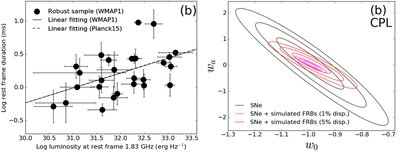 Imaginary picture of FRB. Image credit: [JINGCHUAN YU, BEIJING PLANETARIUM/NRAO]
Imaginary picture of FRB. Image credit: [JINGCHUAN YU, BEIJING PLANETARIUM/NRAO]
Recently astronomers are excited in mysterious bursts in radio wavelength in the Universe, i.e., Fast Radio Burst (FRB). The FRB is a new emerging population with a millisecond time scale. The busts come from the cosmological distant Universe. The event rate is much more frequent than Gamma-Ray Bursts (GRBs). The origin remains unknown.
I, for the first time, discovered a positive correlation between the luminosity and duration of FRBs (Fig. 1 left).

Any physical models need to predict the relation. Among ~50 models, favored theories include Active galactic nuclei, comet collision, and supernova remnant. There is an ‘alien theory’ of FRBs, which also predicts the positive correlation.
The relation is also important in terms of Cosmology. The relation allows us to estimate intrinsic luminosities of FRBs from the measured duration. This is a new ‘standard candle’ to measure distances in the Universe, like type Ia supernovae. Type Ia supernova revealed the existence of the ‘Dark Energy’ in the Universe.
FRBs can reach the more distant Universe than type Ia supernova, and happen quite frequently. My simulations (Fig. 1 right) indicate that the luminosity-duration relation of the FRBs will provide tight constraints on the nature of ‘Dark Energy’, i.e., time variability of the Dark Energy that is one of the most biggest mysteries in the modern astronomy, when FRBs are discovered in quantity by next-generation radio telescopes such as the Square Kilometre Array (SKA) in the future.
This project is based on the following publication.
Tetsuya Hashimoto, Tomotsugu Goto, Ting-Wen Wang, Seong Jin Kim, Yi-Han Wu, and Chien-Chang Ho, 'Luminosity-duration relation of fast radio bursts' , Monthly Notices of the Royal Astronomical Society, (2019).
The publication was featured by New Scientist, 'Mysterious signals from space could teach us how dark energy works' , 8 Aug. (2019)